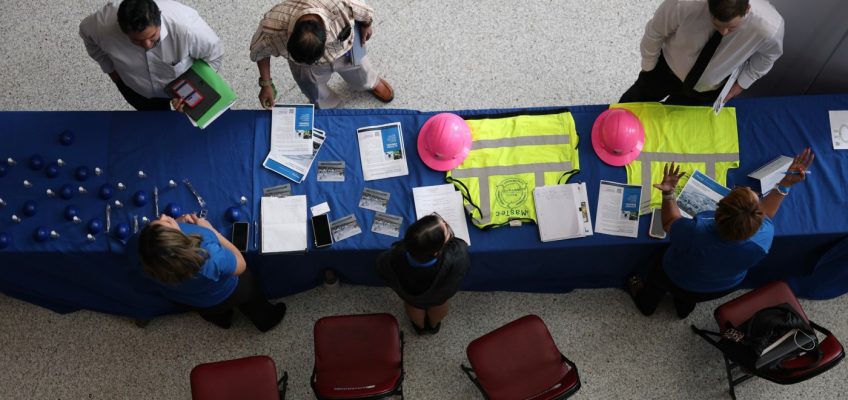A bevy of youth organizations are pressing lawmakers to pass the “Livable Futures” package—five bills focused on immigration, climate change, housing and transgender rights, crafted in part to push back against Trump administration policies.
Members of several youth organizations with elected officials at the launch of their “Livable Futures” campaign earlier this fall. (Ayman Siam/Office of NYC Comptroller)
This story was produced by an alum of City Limits’ youth journalism training program, CLARIFY (City Limits Accountability Program for Youth)
This fall, 150 New York City youth gathered with elected officials in Brooklyn advocating for lawmakers to pass the “Livable Future” package before the end of this year.
Consisting of five bills focused on immigration, climate change, housing and transgender rights, the group—members of several youth-run organizations, including Fridays For Future NYC and the Youth Alliance for Housing—are pressing for action from the City Council, in part to push back against policies being carried out by President Donald Trump’s administration.
“The fascists are here. They’re invading our cities, crashing our economy and stealing our futures to sell them to the first bidder,” City Councilmember Chi Ossé said in a short social media video regarding The Livable Future Package.
Ossé, who was 23 when he was elected three years ago as the Council’s youngest member, said his office worked with the participating youth organizations this summer to help craft the legislation. He described the bills as “municipal solutions to national problems.”
The package has also been championed by other elected officials, including Comptroller Brad Lander and Public Advocate Jumaane Williams, and the City Council’s Progressive Caucus voted in October to prioritize the bills for the reminder of this legislative session.
One of the bills, which aims to make it easier for tenant groups and nonprofits to buy distressed buildings, is expected to pass in the coming weeks, as City Limits reported Monday. Another is slated for a Council committee hearing next week.
But with just two full City Council stated meetings left in 2025, lawmakers have limited time left to act this year.
Here’s a look at the bills in question, and why young New Yorkers say they’re supporting them.
Federal immigration officers in The Bronx in January 2025. (Department of Homeland Security photo by Tia Dufour)
Strengthening sanctuary city protections
The first bill introduced by the Livable Future Package is Intro. 214, The New York City Trust Act, which aims to protect New York City’s immigrant population from having their information shared with U.S. Immigration and Customs Enforcement (ICE). Under President Trump, ICE has aggressively ramped up raids throughout the country, targeting both documented and undocumented people.
New York City’s sanctuary laws restrict how city agencies can share information with ICE, which supporters say ensures that immigrant New Yorkers don’t have to live in the shadows, particularly when it comes to reporting crimes and other abuses.
However, the New York Police Department (NYPD) and Department of Corrections (DOC)—both law enforcement city agencies, the DOC being responsible for management of those in custody—have been previously accused of violating the laws.
“New York City has scared people in my community off the streets,” said Hadia Ali, a senior in high school and organizer with the YA-YA Network, a youth organization empowering young people to fight for social and economic justice. “God forbid somebody gets detained or deported.”
Intro. 214 would create a “private right of action,” allowing individuals to file legal complaints, and potentially lawsuits, against any city agency violating their rights under sanctuary rules.
“We have a mayor that’s in the pockets of the federal government, and he’s not interested in upholding the sanctuary city laws that make New York the city that it is,” said Ali, referring to outgoing Mayor Eric Adams, who was facing federal corruption charges until the Trump administration dropped them earlier this year, saying the case interfered with the mayor’s cooperation on the president’s immigration crackdown.
Adams has also called for reforming the city’s existing sanctuary city laws to allow for more cooperation with ICE, citing concerns about public safety.
“This bill would ensure that under any mayor, not just Adams, that the laws that we have in place are being properly and effectively enforced,” Ali said.
Closing building pollution loopholes
Next in the Livable Futures package is Intro. 1180, which strengthens New York City’s Green New Deal for buildings, Local Law 97.
Youth organizers with the Livable Futures coalition painting
a sign. (Courtesy of Livable Futures NYC)
The law, passed in 2019, sets increasingly stricter limits on how much pollution large buildings can produce—requiring property owners to green their buildings and lower their emissions, or pay penalties.
But under program rules set out by Mayor Adams’ administration, building owners can purchase Renewable Energy Credits (RECs) to offset annual building emissions that go over their limits—a response to complaints from real estate groups who said the new rules were too onerous for many landlords to comply with.
But environmental critics say the current REC options are too lax, allowing owners to buy their way out of compliance for up to 50 percent of the pollution they’d otherwise have to clean up.
Intro. 1180 closes this loophole by further limiting REC purchases, meaning building owners could use them to offset no more than 10 percent of emissions over their property’s limits. Supporters say this would compel more landlords to undertake green retrofits, as Local Law 97 intended.
“Basically what that means is making sure that we’re still enforcing the law, making sure that buildings are improving their energy efficiency,” said Keanu Arpels-Josiah, an organizer with Fridays For Future (FFF) NYC, a youth-led climate justice organization started in 2018 by Greta Thunberg.
Expanding community ownership models
The third bill in the package is Intro. 902, The Community Opportunity to Purchase Act (COPA), which is similar to policies implemented in cities like Washington D.C. and San Francisco.
Under COPA, landlords of certain buildings who wish to sell would be required to notify the Department of Housing, Preservation and Development. It would then give nonprofits, including Community Land Trusts (CLTs)—land-owning nonprofits run by representatives and community members—opportunities to bid on those buildings before they’re available on the wider market.
In response to concerns from city housing officials, a recently updated version of the bill specifically targets buildings in financial or physical distress or with expiring affordability requirements, and would give the community groups a 45-day head-start to make an offer.
Buildings owned by a community land trust in the East Village. (Adi Talwar/City Limits)
Real estate groups oppose the legislation, saying it unfairly advantages nonprofits and would disrupt the local housing market. But supporters say real estate transactions in the city are already deeply skewed in favor of deep-pocketed developers and investors, and that COPA would level the playing field.
“We are seeing landlords who no longer want their ‘investment property’ and [who are] selling it to large corporate landlords that begin demolishing it and putting up luxury high rises,” said Kasey McNaughton, director of Organizing for the Youth Alliance for Housing (YAH), a community organization fighting for affordable housing and tenants’ rights.
McNaughton has been with YAH for two and a half years, but has been organizing since she was in high school. “A good portion of our city, our neighbors and our community are rent burdened, and I believe that is fully caused by a system, and a history of a country, that has allowed real estate to continuously put profits over people,” she said.
“[Qualified nonprofits and CLTs] want to be able to purchase these buildings from landlords before big corporations or big real estate conglomerates do, and COPA gives them the first chance to do so.”
Shoring up protections for transgender New Yorkers in jail
The final bills—Intro. 625 and Intro. 1027—secure the rights of Transgender, Gender Nonconforming, Nonbinary and Intersex (TGNCNBI) individuals in New York City jails overseen by the Department of Correction. A similar bill introduced by lawmakers in Albany would apply to New York State prisons, if passed.
According to the National Institutes of Health (NIH), transgender inmates are at higher risk for sexual and physical abuses while incarcerated.
Intro. 625 ensures that TGNCNBI people in city jails are housed safely in accordance with their gender identity and where they feel most safe, while Intro. 1027 ensures they can access gender affirming care and commissary while behind bars.
These bills also create a private right to action, allowing those harmed by a correctional institution’s failure to comply with these laws to more easily seek justice.
“In the past eight months we have been constantly under attack. While yes, over time, the queer community has gained more acceptance and progress; we have regressed so far in terms of our rights and safety since Trump’s first term just because of the amount of legislation being passed targeting us,” stated Lorelei Crean, an internationally recognized transgender activist.
Crean is a lead political organizer for NYC Youth for Trans Rights, a nonprofit started in 2023 after the murder of Brianna Ghey, a transgender teen from the United Kingdom. They have been an activist since childhood, joining the organization in 2024 after Trump’s re-election.
“We the youth are saying that we want a livable future, that we want to feel safe and protected in our future,” said Crean.
Arpels-Josiah, with FFF NYC, said the legislative package as a whole, “is about understanding the future we are fighting for as a generation, as a youth movement.”
“It’s also a future where all these basic human rights are guaranteed, where we’re able to go home and study and afford the rent,” he said.
With additional reporting by Jeanmarie Evelly.
To reach the editor, contact Jeanmarie@citylimits.org. Want to republish this story? Find City Limits’ reprint policy here.
The post 5 Bills NYC Youth Want the City Council to Pass Before the Year Ends appeared first on City Limits.




